Review – Visit to the Lesbian Herstory Archive
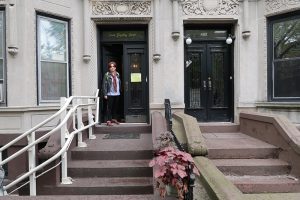 At the beginning of May I visited New York for the first time. I wanted to walk around Manhattan and get a sense of the city. I enjoyed overhearing people’s conversations on park benches, many of them in Spanish, and the surprising sound of birds singing everywhere. I experienced hope with the overwhelming amount of graffiti, stickers, badges, posters, and books opposing Trump in the heart of the city. But I wanted to listen deeper to the stories of lesbian lives in America, and to find common ground, so I left Manhattan for Brooklyn to visit the Lesbian Herstory Archive. I have been a long-time volunteer at the Feminist Library in London and I was told that both archives share similar values. With great timing, the LHA was open for few hours on the Sunday I was there, so I invited my friend Megan, who lives not far from New York, to join me in this exploration.
At the beginning of May I visited New York for the first time. I wanted to walk around Manhattan and get a sense of the city. I enjoyed overhearing people’s conversations on park benches, many of them in Spanish, and the surprising sound of birds singing everywhere. I experienced hope with the overwhelming amount of graffiti, stickers, badges, posters, and books opposing Trump in the heart of the city. But I wanted to listen deeper to the stories of lesbian lives in America, and to find common ground, so I left Manhattan for Brooklyn to visit the Lesbian Herstory Archive. I have been a long-time volunteer at the Feminist Library in London and I was told that both archives share similar values. With great timing, the LHA was open for few hours on the Sunday I was there, so I invited my friend Megan, who lives not far from New York, to join me in this exploration.
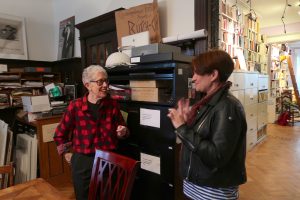 From the outside the Lesbian Herstory Archive has the look of any other house in the neighbourhood. Megan and I felt instantly welcomed from the hall entrance onwards. No security, no library card needed, a zero stress beginning. The archive still looks like a house inside, the rooms full of wonderful lesbian objects. Books, bookmarks, photographs, badges, t-shirts, video tapes, dildos, banners, or anything interesting around the excitement and complexity of living a lesbian life.
From the outside the Lesbian Herstory Archive has the look of any other house in the neighbourhood. Megan and I felt instantly welcomed from the hall entrance onwards. No security, no library card needed, a zero stress beginning. The archive still looks like a house inside, the rooms full of wonderful lesbian objects. Books, bookmarks, photographs, badges, t-shirts, video tapes, dildos, banners, or anything interesting around the excitement and complexity of living a lesbian life.
We were incredibly lucky to meet Deborah Edel, one of the co-founders of the archive back in 1974 who showed us around the archive, giving us a tour of our lesbian herstory. She explained that the collection’s emphasis is on women who have lived an everyday life more than on the lives of famous lesbians. Deborah was there with filmmaker Megan Rossman, who has produced short films about the 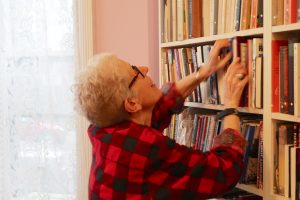 library. She was filming that day, and Megan and I were invited to participate, being filmed as we explored the archive with Deborah. Megan, not my friend but the filmmaker, pressed the record button as we started the tour in the living room, which is full of anthologies, poetry, theatre, science, feminism, sport, humour, photography, pornography, and spoken word. How exciting to be archived too!
library. She was filming that day, and Megan and I were invited to participate, being filmed as we explored the archive with Deborah. Megan, not my friend but the filmmaker, pressed the record button as we started the tour in the living room, which is full of anthologies, poetry, theatre, science, feminism, sport, humour, photography, pornography, and spoken word. How exciting to be archived too!
The archive was originally a house where people lived. Many years ago the women of the LHA raised money to buy the house so they could secure its future. LHA is run by volunteers and has no government funding. It is very well organised with a paper catalogue and many online resources. The material is organised in alphabetical order by women’s first names, and includes items donated from all over the world.
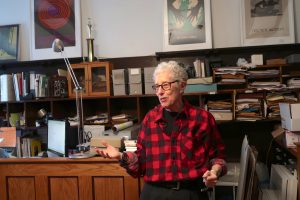 In the basement, a group of volunteers is working very hard to preserve cassettes and videotapes – an urgent task because of the fragility of these technologies. They wear headphones to listen to what was recorded, and sometimes what is written on the cassette labels is incorrect, as a new recording has erased the first contents. Upstairs, in what were the bedrooms and the children’s room, they have more books, but also t-shirts, badges, a guitar, protest jackets, even little origami lesbian nuns. As Deborah said ‘You name it, we have it’.
In the basement, a group of volunteers is working very hard to preserve cassettes and videotapes – an urgent task because of the fragility of these technologies. They wear headphones to listen to what was recorded, and sometimes what is written on the cassette labels is incorrect, as a new recording has erased the first contents. Upstairs, in what were the bedrooms and the children’s room, they have more books, but also t-shirts, badges, a guitar, protest jackets, even little origami lesbian nuns. As Deborah said ‘You name it, we have it’.
The archive is not set up to collect artwork. They refer artists to the Gay and Lesbian Museum instead, but they collect photographs of artwork. Badges are tricky because they can’t be easily dated. This commentary made me want to discuss the idea of the unknown object in an archive space, but I opted to carry on listening.
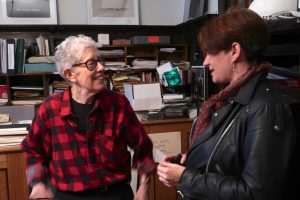 Deborah finished the tour with the story of one of her good friends in the library, Marge, whose books are kept in a bookshelf upstairs. She was the one who raised the first $50 towards buying the building. In the 1980s she was very sick and decided to go to her parents’ house. They were very limited in their thinking. At the reading of her will her parents found out that she was a lesbian, as she wanted to donate her papers and books to the LHA. They got very upset and wanted to destroy her books. A lawyer and a van were hired to come to the family house and rescue such important herstory. Her diaries tell us what it was like to come out in the bars of 1950s Ohio, and deal with the question of who am I?
Deborah finished the tour with the story of one of her good friends in the library, Marge, whose books are kept in a bookshelf upstairs. She was the one who raised the first $50 towards buying the building. In the 1980s she was very sick and decided to go to her parents’ house. They were very limited in their thinking. At the reading of her will her parents found out that she was a lesbian, as she wanted to donate her papers and books to the LHA. They got very upset and wanted to destroy her books. A lawyer and a van were hired to come to the family house and rescue such important herstory. Her diaries tell us what it was like to come out in the bars of 1950s Ohio, and deal with the question of who am I?
As always, the best things in life come in simple forms, for free and with gentle manners. After the visit I felt pleased, and made the resolution of becoming a world correspondent on Lesbian Herstory archives, not for the BBC but maybe for the Feminist Library’s new foreign affairs press department!
http://www.lesbianherstoryarchives.org
Megan Rossman’s previous film about the archive can be seen online here: https://vimeo.com/201355426
Written by Eva Megias.
Photos by Megan Saltzman.
